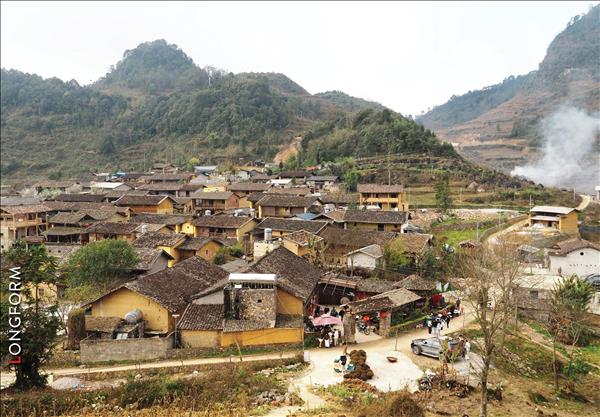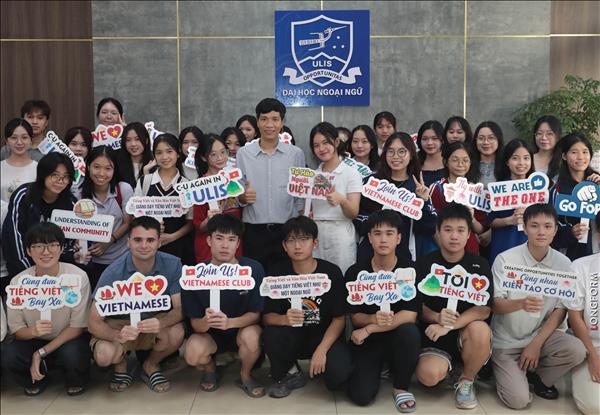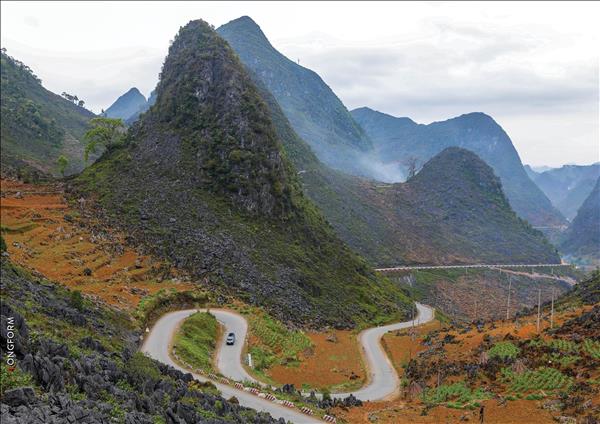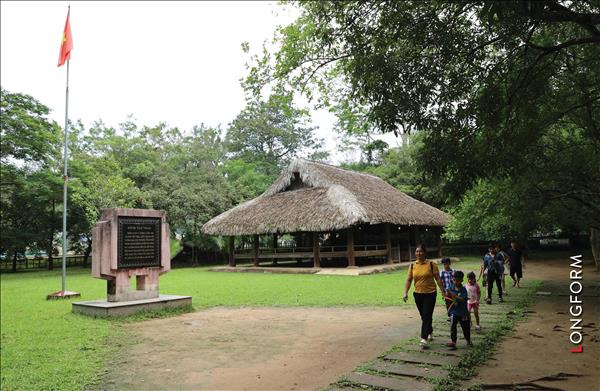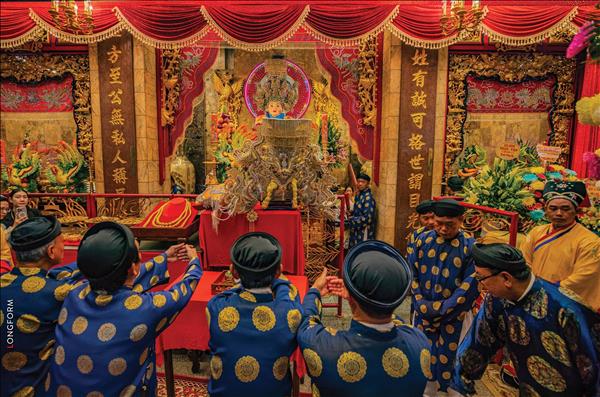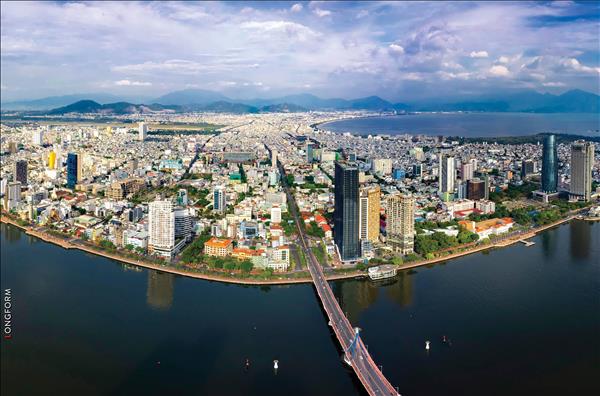Phu Day - The Land for Mother’s Death Anniversary
A Vietnamese saying goes “Thang Tam gio Cha, thang Ba gio Me” (the Father’s Death Anniversary Falls in the Eighth Moon and the Mother’s in the Third Moon), showing gratitude respectively to “Duc Thanh Tran” (Saint Tran) and “Thanh Mau Lieu Hanh” (Mother Saint Lieu Hanh) as the Vietnamese thousands-year-old religious philosophy “uong nuoc nho nguon” (remembering its source when drinking water).
According to many researchers, in the Heritage of Worship of Mother Goddesses, practiced by the Viet ethnic group, Mother Saint Lieu Hanh was referred to as “mau nghi thien ha” (Mother of the World), a nymph who descended to Earth, lived as a human and became one of four immortal saints of the Viet people. She is “Mau Thuong Thien”, the first Mother Goddess having the power to manage the firmament and master supernatural forces such as clouds, rain, wind, storms, thunder and lightning.
In Vietnam, the Mother Goddesses religion in general and the belief of Worship of Mother Goddesses in particular appear in many localities, but Nam Dinh is considered the heart with some 400 Mother Goddesses Worship locations, of which Phu Day becomes the focal point of this belief- practicing activities.
Phu Day lies in Kim Thai commune, Vu Ban district, Nam Dinh province, a well-known architectural complex related to the Viet people’s “Tho Mau Tam Phu” belief. Among 21 architectural works of Phu Day complex, three are closely related to Mother Saint Lieu Hanh, including Tien Huong temple (the principal one), Van Cat temple and Lieu Goddess shrine.
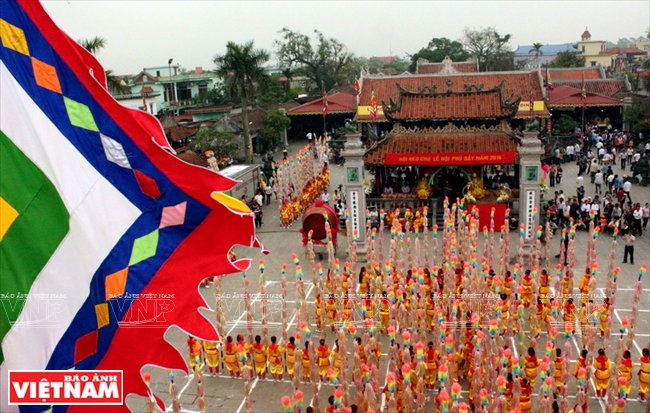 Day Temple worships Mother Saint Lieu Hanh, also known as Mau Thuong Thien who ranks first in the Vietnamese Worship of Mother Goddesses. Photo: Trinh Van Bo/VNP 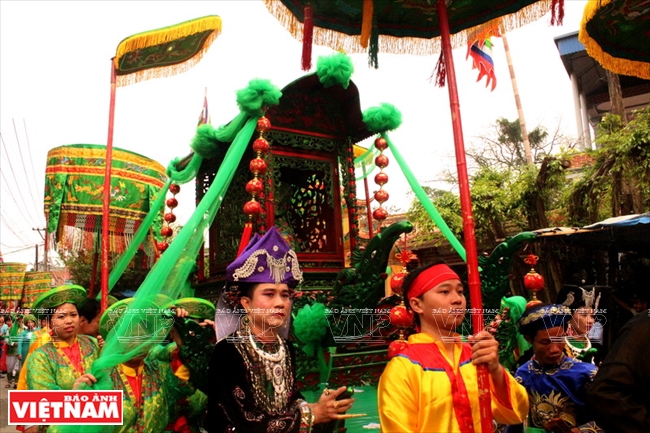 The procession of Mother Goddess at Day Temple in Nam Dinh province. Photo: Trinh Van Bo/VNP Nguyet Du Cung is a typical architectural work inside Phu Day complex. It is believed that Mother Saint Lieu Hanh often goes there to dance and sing during full-moon nights. Photo: Trinh Van Bo/VNP |
| The basic practices of the belief of Worship of Mother Goddesses comprise worshipping rituals, trancing, chanting, rites and festivals, typically of which is the Phu Day festival in Nam Dinh, which takes place in the third lunar month, on the death anniversary of Mother Saint Lieu Hanh. |
As said by cultural researchers, the Phu Day festival is an important component of a great Lieu Hanh historical chorus. This shows that Phu Day is the centre of the Heritage of Worship of Mother Goddesses.
Mother- the Head Goddess in the Vietnamese people’s subconscious
According to Prof. Ngo Duc Thinh, Director of Vietnam Belief Culture Research and Conservation Centre, the Vietnamese people’s “Mau Tam Phu” Worship Practice Heritage was formed and developed on the basis of the belief of worshipping female deities, considering nature a Mother to be worshipped as a supreme deity with the power to create, manage and assist humans, bringing to the latter good health and gifts in the earthly life.
Since the 16th century, the practice of this belief has become a cultural activity of deep and wide impacts in the social life and subconscious of the Vietnamese people.
Tam Phu in the Mother Goddesses Worship belief corresponds to three different regions in universe, namely: “Thien phu” (the Heaven region), “Nhac phu” (the forest and mountain region) and “Thoai phu” (the river and water region). Each region is headed by a mother saint, including “Mau Thuong Thien” (the first Mother) managing the firmament and mastering supernatural powers such as clouds and rain, wind and storms, thunder and lightning; “Mau Thuong Ngan” (the second Mother), looking after the forest and mountain region, the main living habitat of various ethnic minorities, and “ Mau Thoai” (the third Mother), taking care of the rivers and water region, giving benefits for water-rice growing and fishing.
In the Mother Goddesses Worship Temple, Mother Saint Lieu Hanh is always identical to “Mau Thuong Thien” sitting in the middle in a red dress, with “Mau Thoai” sitting on the left in a white dress and “Mau Thuong Ngan” on the right in a green dress.
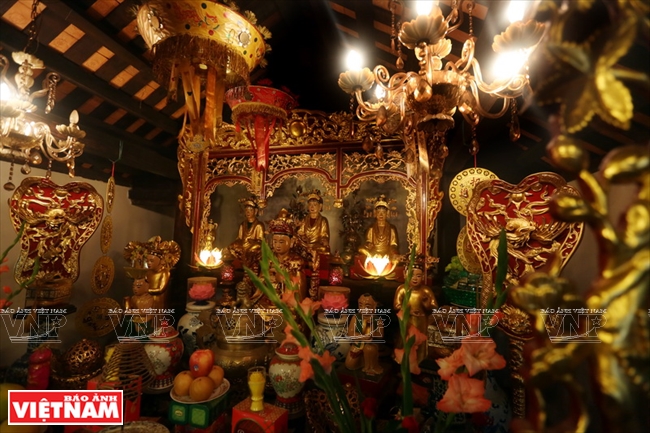 The signature space of an altar for Mother Goddess. Photo: Trinh Van Bo/VNP 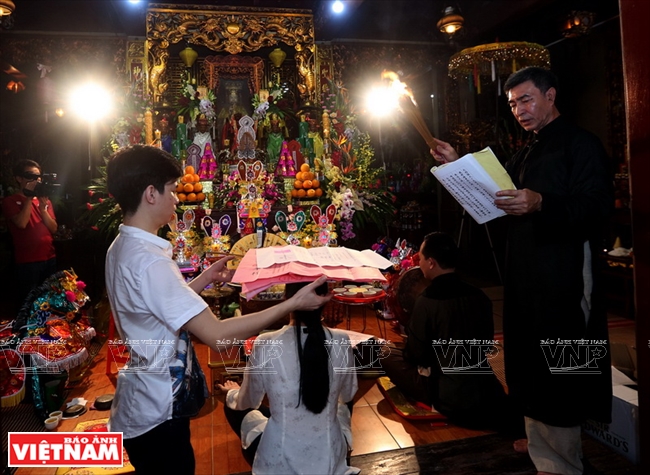 The rites of worshiping wandering spirits and saints in the Worship of Mother Goddesses. Photo: Trinh Van Bo/VNP Indispensable offerings in the Worship of Mother Goddesses. Photo: Trinh Van Bo/VNP  Mediums often perform the rites of worshiping wandering spirits and saints before the “Hau dong” ritual. Photo: Trinh Van Bo/VNP |
| Tam phu include “Thien phu” (the Heaven region), “Nhac phu” (the forest and mountain region) and “Thoai phu” (the river and water region). Each region is headed by a mother goddess, including “Mau Thuong Thien” (the first Mother) managing the firmament, “Mau Thuong Nguon” (the second Mother) looking after forests and mountains, and “ Mau Thoai” (the third Mother), taking care of rivers and the water region. |
Influenced by different religions and beliefs, apart from three supreme goddesses, namely “Mau Thuong Thien”, “Mau Thuong Ngan” and “Mau Thoai”, the Mother Goddesses religion also worships about 50 deities, including many historical personalities, national heroes deified by broad masses of the people, such as Tran Hung Dao and Pham Ngu Lao, as well as deities of various ethnic groups such as the Kinh, a majority and the Tay, Nung and Dao which are minorities. This reveals that the Mother Goddesses Worship Heritage clearly demonstrates the national tradition of “uong nuoc nho nguon”, the spiritualised patriotism, the sense of cultural exchanges and close and equal relationships among nationalities.
Another interesting thing is that the Vietnamese people’s Goddesses Worship belief differs from other religions and beliefs in that it directs humans and their beliefs into the present world, the world where humans are living with their natural and practical aspirations for good health and good fortune while the latter directs humans and their beliefs into the post-mortem world.
Hau dong” - a ritual of doubts and secrets
The Mother Goddesses Worship Heritage is characterised by an extremely special ritual, “chau van - hau dong”.
According to researchers, “hau dong” is, in essence, a form of folk singing and dancing based on the combination between chant singing, a genre of spiritual music with smoothly polished lyrics and inspiring now-presto-now-largo melodies, and lissome dances as well as solemn rites, thus sending humans (the spirit mediums) into a state of possession and ecstasy and a trance.
The mediums are directly practicing the spirit possession rituals. Many people believe that the mediums are persons possessing special capabilities, acting as mediums between humans and spirits. The mediums are the central figures of “hau dong” rituals, being the most prominent persons. They are always beautifully and resplendently made up with fanciful dresses. The mediums faces are always embellished to bear the womanly beauty as a clear feature of venerating and worshipping female deities in the Vietnamese people’s Mother Goddesses Worship belief.
|
Medium Thu Quynh performs in the scene of “Chau luc” at Nguyet Du Cung Temple in Nam Dinh province. Photo: Trinh Van Bo/VNP 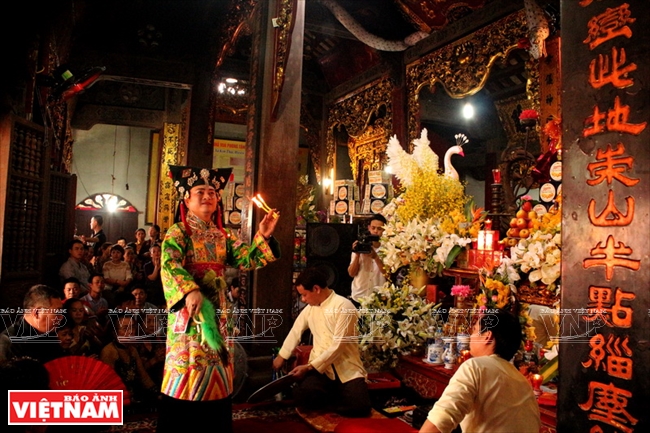 A medium expresses herself through a trance in dances and melodies in the scene of “Chau ba thuong ngan”. Photo: Trinh Van Bo/VNP The sharp glance and brilliant smile of the medium when performing the scene of “Chua ba de nhat Tay Thien”. Photo: Trinh Van Bo/VNP When performing the “Hau dong” ritual, the medium needs two or four assistants who help the medium offer incense and change costumes. Photo: Trinh Van Bo/VNP Doing make-up to prepare for the scene of “Co be thuong ngan”. Photo: Trinh Van Bo/VNP 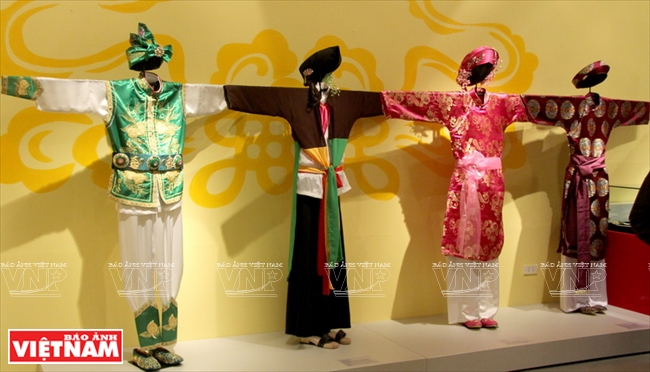 Depending on each scene in the “Hau dong” ritual, the medium will wear a suitable costume that shows the character of each saint. Photo: Trinh VanBo/VNP |
In the “hau dong” ritual, “cung van” (instrumentalists) are persons who play music and sing chants. They have the talents of using lyrics and seductive now-presto-now-largo melodies to send the mediums into the illusive and fantastic world of spirits with the most sublimating emotion, that is the state of trancing fantasy.
Assisting the mediums in the “Hau dong” ritual are two or four “hau dang” (offerings assistants) or “tu tru” (four pillars), who have the task of assisting the mediums in offering joss sticks and objects, changing costumes when the latter change from one spirit possession to another.
In the “Hau dong” ritual, there appear 36 chanting-trancing acts called “gia dong”, each of which tells of a legendary deity.
In trance performances, depending on the significance of each “gia dong”, the mediums will perform different dances such as bare-handed dances, water-spraying dances, joss gift-offering dances, light-offering dances, fan dances, sword dances and bow dances. the mediums’ costumes are colourful and diverse, depending on the contents of each “gia dong” which usually express the characters as well as the origin of the deity.
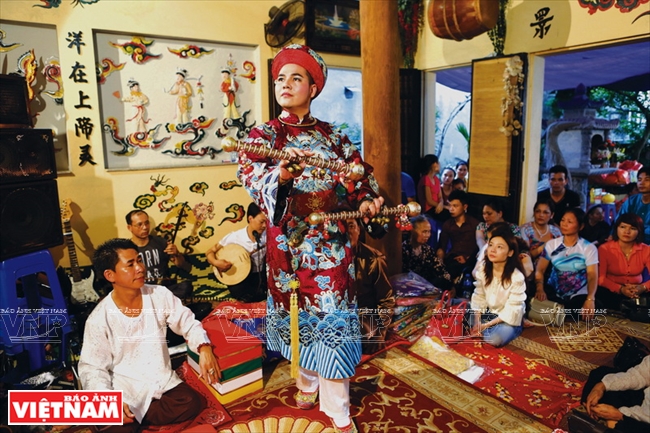 Medium performs the superb manner of “Quan Hoang Bay”. Photo: Trinh VanBo/VNP 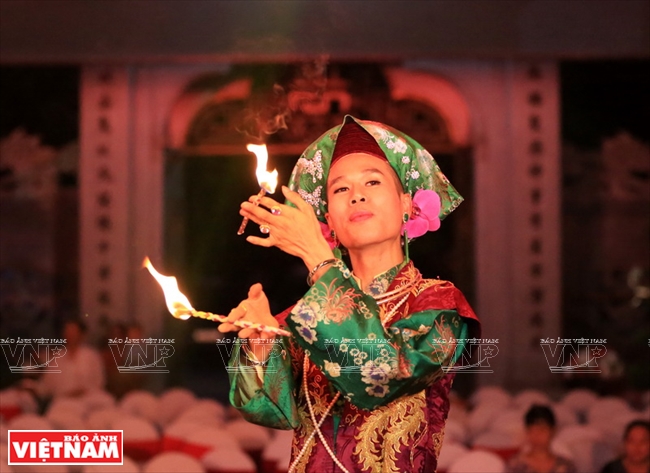 “Chau Ba Đong Cuong” performance. Photo: Trinh VanBo/VNP 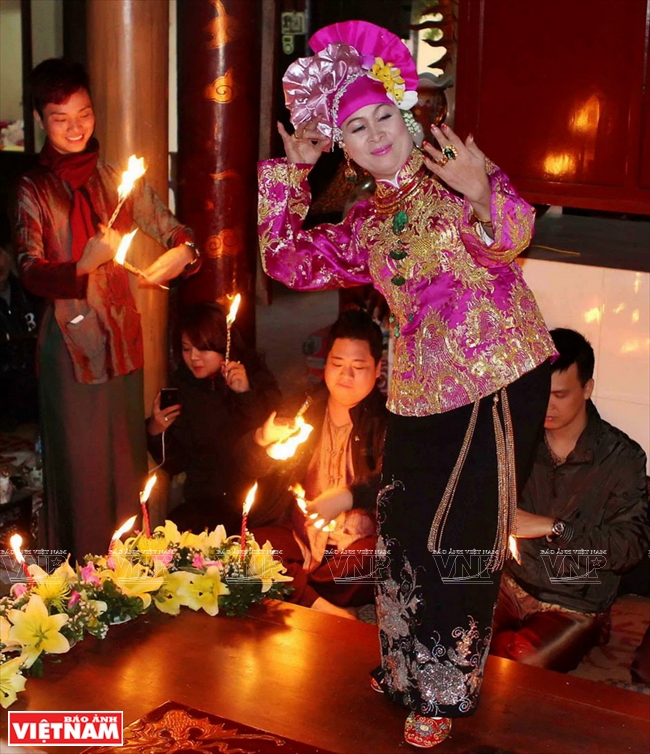 “Chau Co Be” performance. Photo: Trinh VanBo/VNP “Quan Hoang Muoi” performance.Photo: Trinh VanBo/VNP “Cung van” (instrumentalists) are persons who play music and sing chants. They have the talents of using lyrics and seductive now-presto-now-largo melodies to send the mediums into the illusive and fantastic world of spirits with the most sublimating emotion. Photo: Trinh VanBo/VNP Audiences are also sharing the illusive and fantastic world of spirits with the most sublimating emotion. Photo: Trinh VanBo/VNP |
| The Vietnamese people’s Worship of Mother Goddesses belief differs from other religions and beliefs in that it does not direct humans and their beliefs into the post-mortem world, but into the present world, the world where humans are living with their very natural and practical aspirations for good health and prosperity. |
It can be said that the “hau dong” ritual of the Mother Goddesses Worship constitutes a treasure of a very special folk singing-dancing art with numerous legends and interesting stories of deities. They not only create an occult spiritual space but also demonstrate the solemnity and elegance as well as the joy and pure beauty of the Vietnamese in a colourful and polyethnicalcultural world.
With the above special values, on December 1, 2016, the Worship of Mother Goddesses was officially recognised as an Intangible Cultural Heritage of Humanity by UNESCO at the 11th session of the Inter-governmental Committee on Protection of Intangible Cultural Heritages held in Addis Ababa. This is Vietnam’s 11th intangible cultural heritages recognised by UNESCO as the Intangible Cultural Heritage of Humanity.
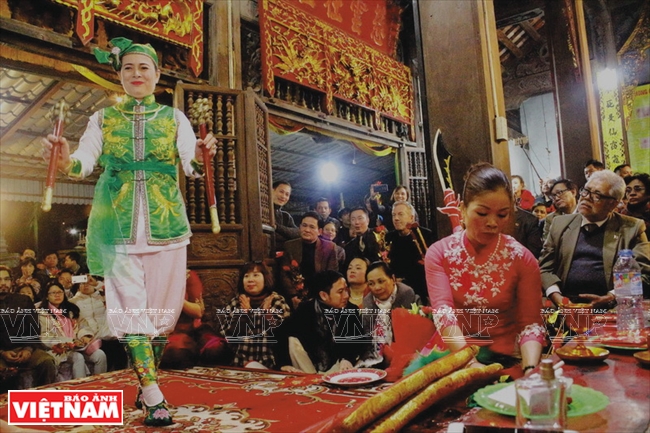 A diplomatic delegation discovers the show.Photo: Trinh VanBo/VNP 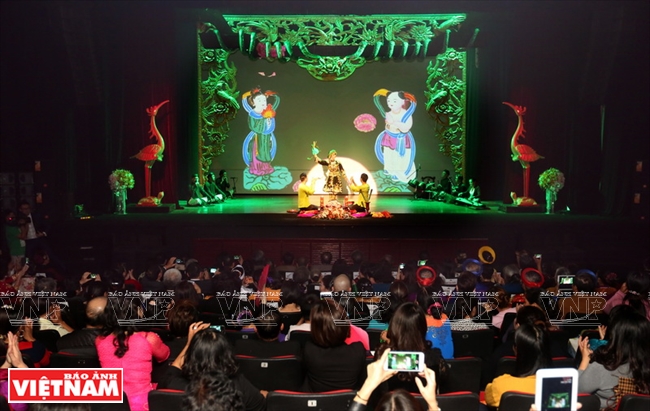 Vietnam’s traditional practice of “Tho Mau Tam Phu” (Worship of Mother Goddesses) is being dramatised to serve the increasing number of audience. Photo: Trinh VanBo/VNP |
Story: Thanh Hoa - Photos: Trinh Van Bo

